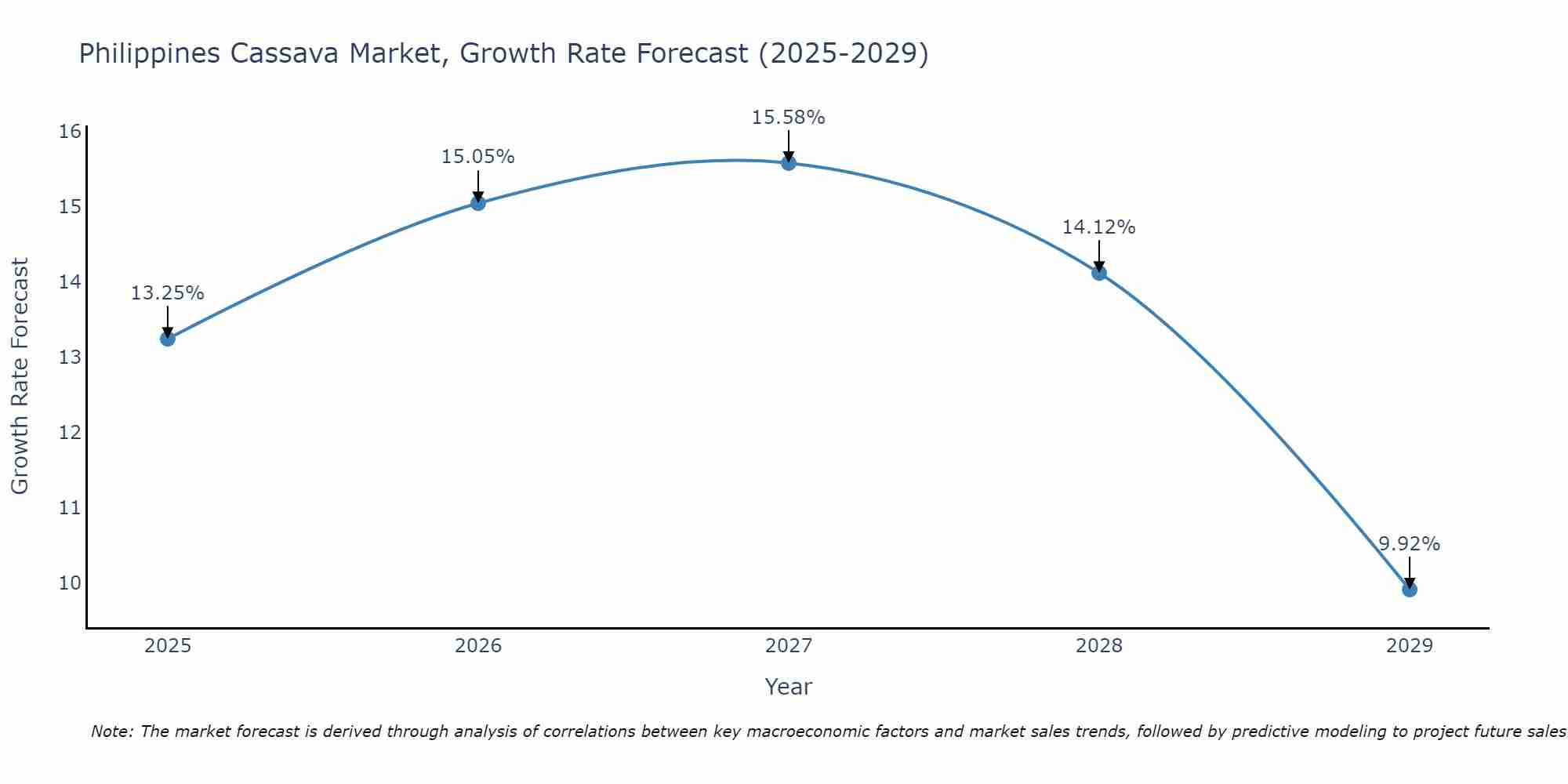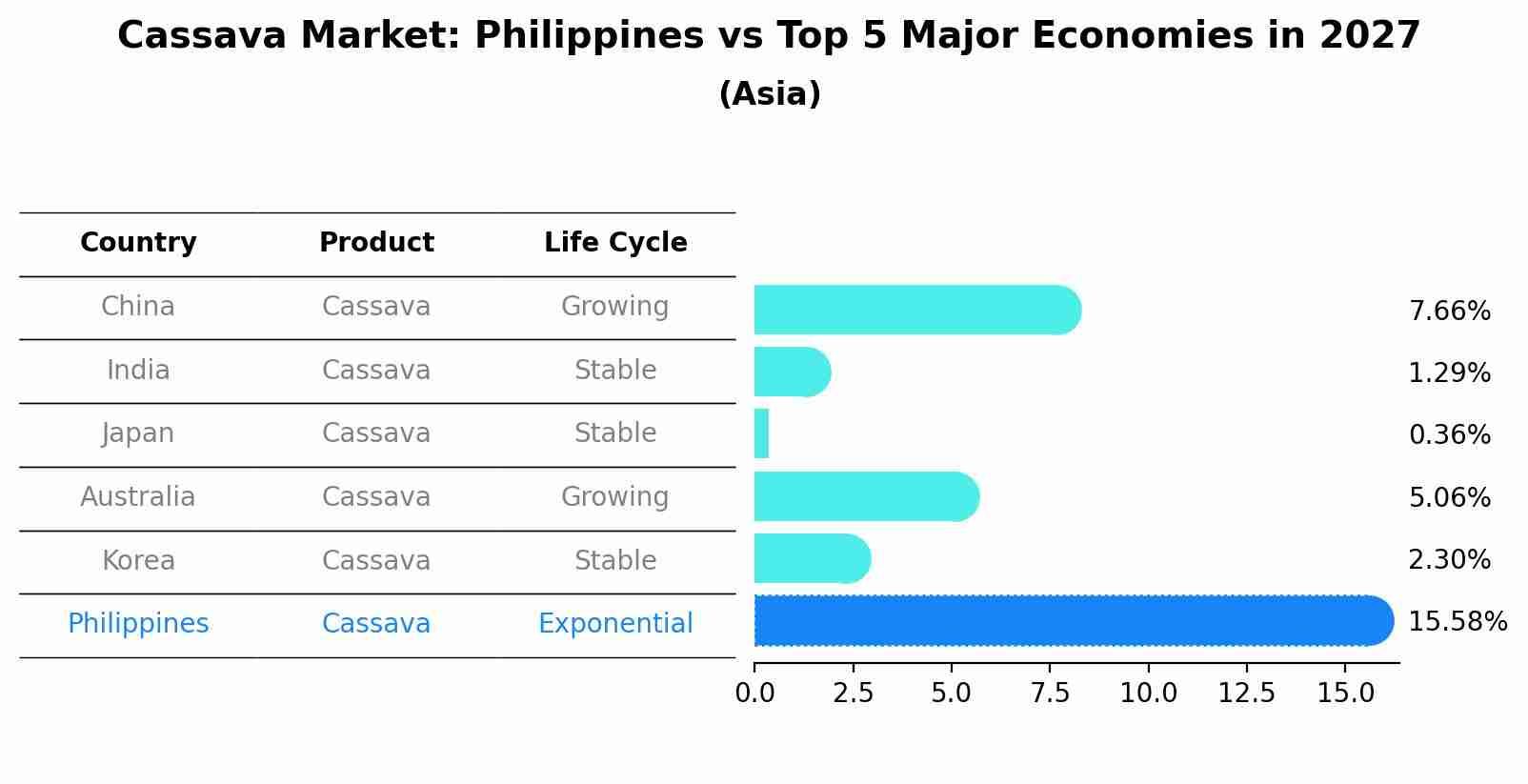Philippines Cassava Market | Trends, Analysis, Growth, Size, Companies, Revenue, Industry, COVID-19 IMPACT, Forecast, Value & Share
| Product Code: ETC176808 | Publication Date: Jan 2022 | Updated Date: Aug 2025 | Product Type: Market Research Report | |
| Publisher: 6Wresearch | Author: Ravi Bhandari | No. of Pages: 70 | No. of Figures: 35 | No. of Tables: 5 |
Philippines Cassava Market Size Growth Rate
The Philippines Cassava Market is projected to witness mixed growth rate patterns during 2025 to 2029. The growth rate begins at 13.25% in 2025, climbs to a high of 15.58% in 2027, and moderates to 9.92% by 2029.

Cassava Market: Philippines vs Top 5 Major Economies in 2027 (Asia)
By 2027, Philippines's Cassava market is forecasted to achieve a exponential growth rate of 15.58%, with China leading the Asia region, followed by India, Japan, Australia and South Korea.

Philippines Cassava Market Synopsis
The Philippines cassava market is the second largest in the world, following only Brazil. In 2019, production of cassava was estimated at 18.3 million metric tons (MMT). This marks an increase from 14 MMT in 2014. The market is projected to rise more in the near future. Approximately 75% of local cassava production is used for human consumption while the remaining 25% is directed towards animal feed and industrial applications such as starch extraction and biofuel production. The demand for cassava has been increasing due to its use as a substitute for wheat flour in baked goods and other food products. The country also exports large volumes of fresh or frozen cassava to international markets such as China, Singapore, Vietnam, Malaysia and Thailand.
Drivers of the market
The Philippines cassava market is driven by several significant factors. Cassava is a staple food in many cultures and regions, contributing to its widespread consumption. It serves as a carbohydrate-rich source of energy, making it a valuable dietary component. Cassava`s versatility in culinary applications, from traditional dishes to processed products like flour and starch, enhances its market presence. The adaptability of cassava to various soil and climate conditions makes it a resilient crop with potential for food security. Additionally, cassava`s potential for use in various industrial applications, including biofuels and animal feed, contributes to its market significance. As efforts to promote sustainable agriculture and reduce food waste increase, the value of cassava as a versatile and resource-efficient crop becomes more apparent.
Challenges of the market
The Philippines cassava market faces challenges associated with production, processing, and market acceptance. Cassava, while a staple in some regions, may face competition from other carbohydrate sources. Ensuring sustainable cassava cultivation involves addressing issues like pest and disease management, optimizing land use, and promoting efficient cultivation practices. Additionally, the market potential for cassava-based products beyond traditional consumption needs to be explored. Establishing processing facilities for cassava into value-added products requires investment and technological know-how. Moreover, promoting cassava products as a nutritious and versatile ingredient requires consumer education and changing perceptions about cassava`s potential.
Covid-19 Impact of the market
The Philippines cassava market underwent a series of adjustments and adaptations due to the COVID-19 pandemic. With disruptions in supply chains, labor shortages, and shifts in consumer behavior, the demand for cassava faced challenges. The closure of foodservice establishments and reduced food processing impacted the demand for cassava products, often used as ingredients in various culinary applications. However, the surge in home cooking and a growing interest in locally sourced ingredients led to increased demand for fresh cassava in retail markets. The market had to adjust to changing consumption patterns by emphasizing the versatility of cassava and promoting its use in home-based recipes. Ensuring a consistent supply of high-quality cassava posed challenges due to sourcing difficulties and transportation disruptions. The Philippines cassava market responded by tapping into local sourcing networks, focusing on retail distribution, and enhancing safety measures to maintain the supply of this essential root crop.
Key Players of the market
In the Philippines cassava market, various players contribute to the production and supply of this starchy root vegetable. Companies like CassavaHarvest Farms, StarchCrafters Inc., and NutriCassava Producers play a significant role in cultivating and distributing cassava, which is used in both traditional dishes and industrial applications.
Key Highlights of the Report:
- Philippines Cassava Market Outlook
- Market Size of Philippines Cassava Market, 2023
- Forecast of Philippines Cassava Market, 2030
- Historical Data and Forecast of Philippines Cassava Revenues & Volume for the Period 2020-2030
- Philippines Cassava Market Trend Evolution
- Philippines Cassava Market Drivers and Challenges
- Philippines Cassava Price Trends
- Philippines Cassava Porter's Five Forces
- Philippines Cassava Industry Life Cycle
- Historical Data and Forecast of Philippines Cassava Market Revenues & Volume By Category for the Period 2020-2030
- Historical Data and Forecast of Philippines Cassava Market Revenues & Volume By Organic for the Period 2020-2030
- Historical Data and Forecast of Philippines Cassava Market Revenues & Volume By Conventional for the Period 2020-2030
- Historical Data and Forecast of Philippines Cassava Market Revenues & Volume By Form for the Period 2020-2030
- Historical Data and Forecast of Philippines Cassava Market Revenues & Volume By Solid for the Period 2020-2030
- Historical Data and Forecast of Philippines Cassava Market Revenues & Volume By Liquid for the Period 2020-2030
- Historical Data and Forecast of Philippines Cassava Market Revenues & Volume By Application for the Period 2020-2030
- Historical Data and Forecast of Philippines Cassava Market Revenues & Volume By Food & Beverages for the Period 2020-2030
- Historical Data and Forecast of Philippines Cassava Market Revenues & Volume By Animal Feed for the Period 2020-2030
- Historical Data and Forecast of Philippines Cassava Market Revenues & Volume By Others for the Period 2020-2030
- Philippines Cassava Import Export Trade Statistics
- Market Opportunity Assessment By Category
- Market Opportunity Assessment By Form
- Market Opportunity Assessment By Application
- Philippines Cassava Top Companies Market Share
- Philippines Cassava Competitive Benchmarking By Technical and Operational Parameters
- Philippines Cassava Company Profiles
- Philippines Cassava Key Strategic Recommendations
Frequently Asked Questions About the Market Study (FAQs):
1 Executive Summary |
2 Introduction |
2.1 Key Highlights of the Report |
2.2 Report Description |
2.3 Market Scope & Segmentation |
2.4 Research Methodology |
2.5 Assumptions |
3 Philippines Cassava Market Overview |
3.1 Philippines Country Macro Economic Indicators |
3.2 Philippines Cassava Market Revenues & Volume, 2020 & 2030F |
3.3 Philippines Cassava Market - Industry Life Cycle |
3.4 Philippines Cassava Market - Porter's Five Forces |
3.5 Philippines Cassava Market Revenues & Volume Share, By Category, 2020 & 2030F |
3.6 Philippines Cassava Market Revenues & Volume Share, By Form, 2020 & 2030F |
3.7 Philippines Cassava Market Revenues & Volume Share, By Application, 2020 & 2030F |
4 Philippines Cassava Market Dynamics |
4.1 Impact Analysis |
4.2 Market Drivers |
4.2.1 Increasing demand for cassava-based products in the food and beverage industry |
4.2.2 Government support and initiatives to promote cassava cultivation and processing |
4.2.3 Growing awareness about the nutritional benefits of cassava as a gluten-free and versatile ingredient |
4.3 Market Restraints |
4.3.1 Vulnerability to weather conditions and natural disasters affecting cassava cultivation |
4.3.2 Price fluctuations in the agricultural market impacting cassava farmers' income stability |
5 Philippines Cassava Market Trends |
6 Philippines Cassava Market, By Types |
6.1 Philippines Cassava Market, By Category |
6.1.1 Overview and Analysis |
6.1.2 Philippines Cassava Market Revenues & Volume, By Category, 2020-2030F |
6.1.3 Philippines Cassava Market Revenues & Volume, By Organic, 2020-2030F |
6.1.4 Philippines Cassava Market Revenues & Volume, By Conventional, 2020-2030F |
6.2 Philippines Cassava Market, By Form |
6.2.1 Overview and Analysis |
6.2.2 Philippines Cassava Market Revenues & Volume, By Solid, 2020-2030F |
6.2.3 Philippines Cassava Market Revenues & Volume, By Liquid, 2020-2030F |
6.3 Philippines Cassava Market, By Application |
6.3.1 Overview and Analysis |
6.3.2 Philippines Cassava Market Revenues & Volume, By Food & Beverages , 2020-2030F |
6.3.3 Philippines Cassava Market Revenues & Volume, By Animal Feed, 2020-2030F |
6.3.4 Philippines Cassava Market Revenues & Volume, By Others, 2020-2030F |
7 Philippines Cassava Market Import-Export Trade Statistics |
7.1 Philippines Cassava Market Export to Major Countries |
7.2 Philippines Cassava Market Imports from Major Countries |
8 Philippines Cassava Market Key Performance Indicators |
8.1 Average yield per hectare of cassava cultivation |
8.2 Adoption rate of modern agricultural practices in cassava farming |
8.3 Percentage of cassava production used for value-added products such as starch, flour, and biofuels |
9 Philippines Cassava Market - Opportunity Assessment |
9.1 Philippines Cassava Market Opportunity Assessment, By Category, 2020 & 2030F |
9.2 Philippines Cassava Market Opportunity Assessment, By Form, 2020 & 2030F |
9.3 Philippines Cassava Market Opportunity Assessment, By Application, 2020 & 2030F |
10 Philippines Cassava Market - Competitive Landscape |
10.1 Philippines Cassava Market Revenue Share, By Companies, 2023 |
10.2 Philippines Cassava Market Competitive Benchmarking, By Operating and Technical Parameters |
11 Company Profiles |
12 Recommendations |
13 Disclaimer |
- Single User License$ 1,995
- Department License$ 2,400
- Site License$ 3,120
- Global License$ 3,795
Search
Thought Leadership and Analyst Meet
Our Clients
Related Reports
- Afghanistan Apparel Market (2026-2032) | Growth, Outlook, Industry, Segmentation, Forecast, Size, Companies, Trends, Value, Share, Analysis & Revenue
- Canada Oil and Gas Market (2026-2032) | Share, Segmentation, Value, Industry, Trends, Forecast, Analysis, Size & Revenue, Growth, Competitive Landscape, Outlook, Companies
- Germany Breakfast Food Market (2026-2032) | Industry, Share, Growth, Size, Companies, Value, Analysis, Revenue, Trends, Forecast & Outlook
- Australia Briquette Market (2025-2031) | Growth, Size, Revenue, Forecast, Analysis, Trends, Value, Share, Industry & Companies
- Vietnam System Integrator Market (2025-2031) | Size, Companies, Analysis, Industry, Value, Forecast, Growth, Trends, Revenue & Share
- ASEAN and Thailand Brain Health Supplements Market (2025-2031) | Strategy, Consumer Insights, Analysis, Investment Trends, Opportunities, Growth, Size, Share, Industry, Revenue, Segments, Value, Segmentation, Supply, Forecast, Restraints, Outlook, Competition, Drivers, Trends, Demand, Pricing Analysis, Competitive, Strategic Insights, Companies, Challenges
- ASEAN Bearings Market (2025-2031) | Strategy, Consumer Insights, Analysis, Investment Trends, Opportunities, Growth, Size, Share, Industry, Revenue, Segments, Value, Segmentation, Supply, Forecast, Restraints, Outlook, Competition, Drivers, Trends, Demand, Pricing Analysis, Competitive, Strategic Insights, Companies, Challenges
- Europe Flooring Market (2025-2031) | Outlook, Share, Industry, Trends, Forecast, Companies, Revenue, Size, Analysis, Growth & Value
- Saudi Arabia Manlift Market (2025-2031) | Outlook, Size, Growth, Trends, Companies, Industry, Revenue, Value, Share, Forecast & Analysis
- Uganda Excavator, Crane, and Wheel Loaders Market (2025-2031) | Strategy, Consumer Insights, Analysis, Investment Trends, Opportunities, Growth, Size, Share, Industry, Revenue, Segments, Value, Segmentation, Supply, Forecast, Restraints, Outlook, Competition, Drivers, Trends, Demand, Pricing Analysis, Competitive, Strategic Insights, Companies, Challenges
Industry Events and Analyst Meet
Whitepaper
- Middle East & Africa Commercial Security Market Click here to view more.
- Middle East & Africa Fire Safety Systems & Equipment Market Click here to view more.
- GCC Drone Market Click here to view more.
- Middle East Lighting Fixture Market Click here to view more.
- GCC Physical & Perimeter Security Market Click here to view more.
6WResearch In News
- Doha a strategic location for EV manufacturing hub: IPA Qatar
- Demand for luxury TVs surging in the GCC, says Samsung
- Empowering Growth: The Thriving Journey of Bangladesh’s Cable Industry
- Demand for luxury TVs surging in the GCC, says Samsung
- Video call with a traditional healer? Once unthinkable, it’s now common in South Africa
- Intelligent Buildings To Smooth GCC’s Path To Net Zero


















